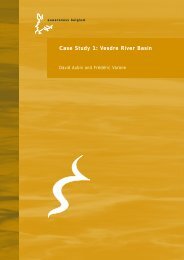Case Study 1: Matarraña River Basin - Euwareness
Case Study 1: Matarraña River Basin - Euwareness
Case Study 1: Matarraña River Basin - Euwareness
You also want an ePaper? Increase the reach of your titles
YUMPU automatically turns print PDFs into web optimized ePapers that Google loves.
external and those internal to the regime. Regarding the former, one of the external<br />
factors which appears to be crucial in the case has to do with climate conditions. In<br />
periods of severe draught —as it was the case of 1998—, draught periods, insofar as<br />
they threaten crops survival and population supply, intensify conflict between actors<br />
claiming for the construction of regulation infrastructures and those reacting against it<br />
and in favour of preserving the resource. Climate conditions, then, precipitate conflict<br />
but do not explain change —given that draught periods have been recurrent all the time<br />
and are a salient characteristic of the Mediterranean climate. However, it can be<br />
considered as an intermediate variable in two senses: on the one hand, it exacerbates<br />
conflict among actors operating at different areas of the river basin; on the other hand,<br />
in the conditions given in the late nineties, it allows for a change of the problem<br />
perception. But, what are these conditions?<br />
Among these interrelated conditions we can include a change of values, a change of<br />
the type of policy network, and the provision of new scientific knowledge about water in<br />
the <strong>Matarraña</strong> river basin. To begin with, a change of values against the traditional<br />
policy approach and in favour of the conservation of the resource emerge in the higher<br />
river basin. These emerging values initially could be interpreted in territorial terms, as<br />
are mostly carried by the expropriated by the works of the pumping system. So, to<br />
some extent, it can be interpreted that these interests have nothing to do with the<br />
conservation of the resource. However, as opposition to the pumping system<br />
increases, a conservationist coalition becomes stronger, attracts and gets support from<br />
other actors operating at different levels of governance: university experts, regional and<br />
national environmental groups. As we explained in the second phase of the evolution of<br />
the regime, there was also a social opposing movement against the traditional water<br />
policy perspective and for a new water culture emerging at a regional level. Later on,<br />
when the CHE proposes the opening of wells to take water from the aquifer in the<br />
higher basin, a line of dialogue between actors located along the river basin is opened.<br />
The initial common denominator to all these actors is their perception of the oldfashioned,<br />
static, slow, hierarchical and outsider nature of the CHE. New scientific<br />
knowledge about the reiterative technical problems of the regulation works promoted<br />
by the CHE reinforce this view. Later on, and being coincident with the scarcity problem<br />
pressure, the common denominator turns to be the preservation of the river as the<br />
unique axis of social and economic development of the area. So a change of values<br />
and interests initially located at the higher river basin extends along the whole river<br />
basin.<br />
63



